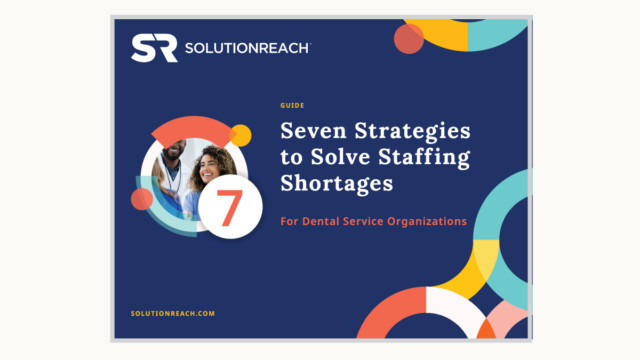Expanding a dental support organization (DSO) or vision group to multiple locations is exciting—until you realize how tough it can be to keep every patient’s experience top-notch. With a mix of different patient populations, various communication tools, and busy staff, your brand consistency can quickly unravel. So how do you ensure consistent communication and reliable patient engagement at every practice without losing your mind? Here’s a helpful roadmap to guide you.
Why is multi-location growth so challenging?
Picture this: You’ve got several practices under your umbrella, each serving a unique community. One location might see more walk-ins, another might rely heavily on online bookings. Maybe you’ve inherited different software systems along the way. Suddenly, it’s nearly impossible to keep track of who needs appointment reminders, who needs a follow-up, and whether all patients are even receiving the same level of service.
It’s not just about juggling multiple platforms; it’s also about the patient experience—how your messaging sounds, when it’s sent, and if it aligns with your organization’s overall brand. The more locations you add, the trickier it gets to maintain consistency and quality across different locations. In fact, 60% of patients say they would switch providers for a better digital experience.
Where do most DSOs and vision groups stumble with growing their healthcare organizations?
There’s a lot of talk about “growing pains,” but let’s get specific:
Disparate communication systems
If each location uses its own platform for appointment reminders, scheduling, and follow-up visits, the result is messy data silos and zero visibility into the big picture.
Uneven brand experience
Patients at one location might receive polished text appointment or recall reminders while another sends generic emails or none at all. This can be confusing and dilute your brand. According to Forbes, brand consistency can increase revenue by up to 23%.
Overworked staff
When front office staff juggle multiple administrative tasks, it’s easy for messages to slip through the cracks or for follow-ups to be delayed—leading to missed appointments and frustrated patients, and even compromised health outcomes.
These pain points underscore why so many DSOs and vision groups desperately need a cohesive strategy to streamline communications and maintain consistent, patient-centered care.
How does a centralized patient communication dashboard and automation save the day?
Imagine a single, user-friendly platform that handles all your patient outreach—appointment reminders, online scheduling, follow-up or recall notifications, and even patient surveys and online reviews. That’s the promise of centralized dashboards coupled with automated communication.
- One-stop view: With a unified system, you can see metrics from every location in real time. If a certain practice has an uptick in missed appointments, you know immediately and can act fast. Healthcare organizations with centralized scheduling systems saw a 20% increase in patient throughput.
- Automated templates: Want a standardized text appointment or payment reminder with your logo and the same friendly tone? Automation makes it possible to roll out consistent patient messaging for every practice without staff having to manually press “send.”
- Customized workflows: Set specific rules for appointment confirmations, cancellations, or even ASAP waitlists. Once established, automation will handle the scheduling load and free up human teams for more personal patient care and improved health outcomes.
This streamlined approach helps you spot patterns quickly and fix issues before they spiral out of control. You’ll maintain a unified brand identity across all your sites—no more mismatched messaging.
Why should you care about standardizing patient communication and engagement systems?
In a world where convenience often outranks cost, an inconsistent or chaotic patient experience can seriously hurt your bottom line. Patients expect a certain level of tech-savvy communication skills—especially if you market your practice group as progressive and patient-focused. In fact, 81% of consumers say a good patient experience is very important when interacting with healthcare professionals, and of those, 41% say they would switch healthcare providers for more effective communication.
By standardizing how and when you communicate, you build trust and confidence that your DSO or vision group is on top of its game. Patients who consistently have positive experiences are much more likely to book follow-up appointments, recommend your practice to friends, and leave glowing online reviews.
How can you get started?
Audit your current tools
Make a list of every communication and scheduling platform used by each location. Are they integrated with your main systems? Is there overlap that wastes money or staff hours?
Choose a central platform
Look for enterprise solutions that integrate with your existing EHR systems and offer dashboards giving you comprehensive insights. The platform should also feature automated, customizable messaging.
Standardize messaging
Develop templates for appointment reminders, scheduling confirmations, and follow-up notes. Establish a clear tone of voice, length, and timing so each location sounds like it’s part of the same family.
Train and test
It’s tempting to flip a switch and roll out new tech, but starting small and making informed decisions can save headaches. Begin with a pilot location, gather feedback, and refine your approach before scaling it across medical practices.
What results can you expect from scaling and standardizing your healthcare group’s patient communication?
- Better patient retention: Consistent, effective communication keeps patients in the loop, reducing appointment no-shows and cancellations.
- Happier staff: Automation offloads repetitive tasks, letting your team focus on more meaningful patient interactions.
- Enhanced brand credibility: Uniform messaging and professional templates show patients they can count on the same great experience no matter which location they visit.
- Actionable insights: With all your data in one place, you can track performance metrics like appointment volume, appointment and recall reminder open rates, and patient satisfaction scores.
Where do we go from here?
You’ve got the blueprint. Now it’s time to make sure your DSO or vision group becomes known for delivering a stellar patient experience every time, everywhere. By consolidating your technology stack, standardizing your communications, and fully embracing automation, you can keep the momentum going no matter how many locations you add.
Remember, multi-location practice growth doesn’t have to mean chaos—and patients certainly don’t want to hear excuses about mixed messages or late follow-ups. A streamlined, centralized approach to patient engagement means you’re ready to meet the rising expectations of today’s healthcare consumers. So go ahead, unify those processes, and watch your organization thrive.
In a nutshell, standardizing your patient engagement strategy isn’t just nice to have—it’s an essential component of DSOs and vision groups looking to stand out, scale smoothly, and keep patients smiling.

To learn more about how to overcome challenges with individual location staff burnout, download the guide “7 Strategies to Solving Staffing Shortages for Dental Service Organizations.”
Download Guide


